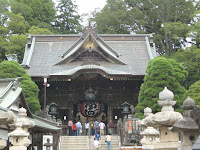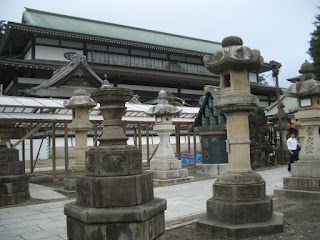Naritasan Shinsoji is a Shingon Buddhist temple located close to the Narita airport in Tokyo...and is the first and the easiest peep into Japanese culture and heritage for someone from outside. A string of Japanese temples and monuments adorn the complex with the oldest structures dating back to 10th century AD. The temple owes it's origin to a military victory of a Japanese kingdom against a powerful samurai. Founded by a Shingon priest named Kancho Daisojo, a disciple of the Shingon founder Kobo Daisi (Kukai), the temple is dedicated to Fudo Myoo (Acala in Sanskrit), the God of Fire.
According to the legends, Kobo Daisi had constructed the image of Fudo Myoo himself and had given the image to Kancho Daisojo, when he accompanied the soldiers during the battle against the rebel samurai. Post the victory, the image of Fudo Myoo became too heavy to be carried back and the temple was constructed to house the image. And it was named Shinshoji (Victory Temple). This image, it is believed, is enshrined in the Main Hall to be displayed during special occasions. During the second half of the last millennium, the temple flourished under different patrons and newer structures were added within the temple complex. Some of the popular ones include the Komyo-Do (dedicated to Vairocana, the principal image of Shingon Buddhism), the Shaka-Do (Shakyamuni hall), the three storied Pagoda and the Kaizen-do (shrine to Kancho Daisojo). The temple has its own garden too...a beautiful one.
 |
This temple complex is one of the best places in Japan to get a feel of the Shingon Buddhism or Esoteric Buddhism. In other words, one of the surviving lineages of the Vajrayana sect. The journey of this sect from India to China and finally to Japan is intriguing to say the least. The word "Shingo" is the Japanese derivative of the Chinese "Zhenyan" which in turn is derived from the Sanskrit "Mantra". At times, I am amazed to read the impact and influence of Sanskrit in shaping the ancient global history. Its a pity that new generation India is not sufficiently equipped to appreciate this fact.
 |
 |
As per esoteric Buddhism or Shingon, the expounder is the universal Buddha Viarocana. The first human to receive the doctrine was Nagarjuna in India. The Indian influence continued as the sect progressed under the patriarchies of Nagabodhi, Vajrabodhi and Amoghavajra. Soon the sect progressed through China and the concept almost died in India. Huigio followed Amoghavajra and then transmitted the secrets to Kobo Daishi. Thus, traveled the spirit from India to China before reaching Japan. As per esoteric Buddhism, knowledge cannot be passed on directly by words, but has to be transmitted through mantras and mudras. Unfortunately, India couldn't retain this ancient wisdom. Nevertheless, this is a part of cultural dynamics, migration and evolution.
 A trip to the Naritasan Shinshoji is incomplete without a relaxed walk through the Omotesando shopping street. This street connects the temple with the train stations and houses some charming traditional Japanese shops and outlets both for souvenirs and food.
A trip to the Naritasan Shinshoji is incomplete without a relaxed walk through the Omotesando shopping street. This street connects the temple with the train stations and houses some charming traditional Japanese shops and outlets both for souvenirs and food.
The temple can be easily reached from the Narita International Airport by trains (either the Narita Line or the Keisei Line (a ten minutes ride), followed by a walk through the Omotesando. I had visited this place long back...during my early twenties...without any knowledge of the history of the place. Even then, this introduced me to Japan for the first time...and my admiration for the country and its people only grew with time.



Comments
Post a Comment